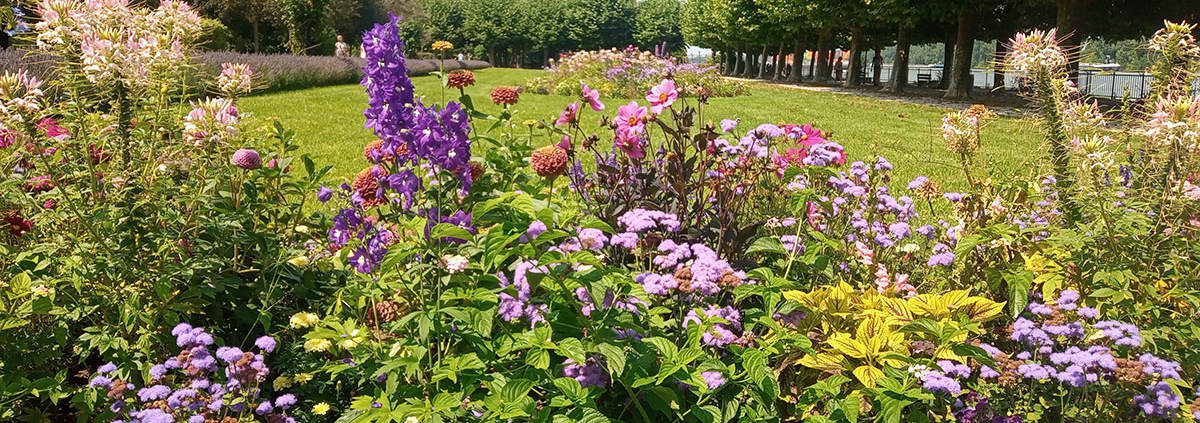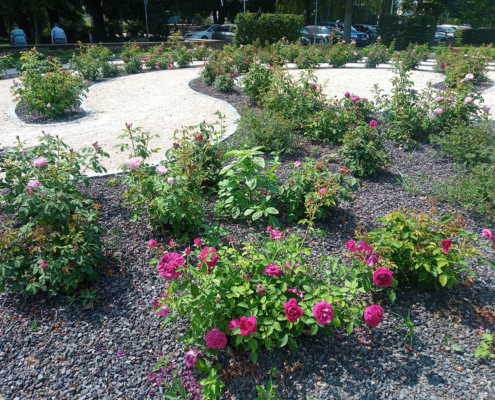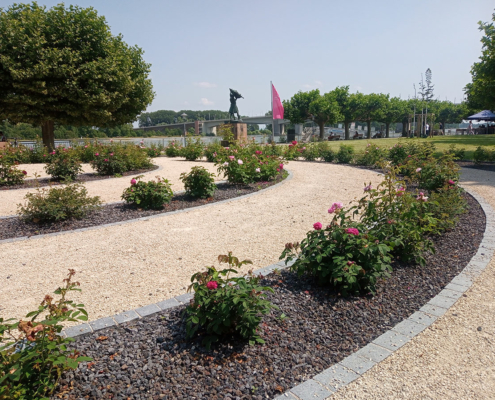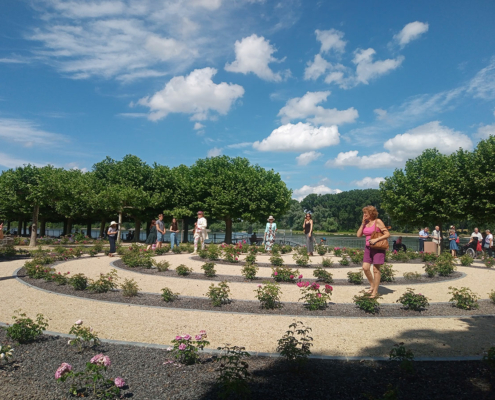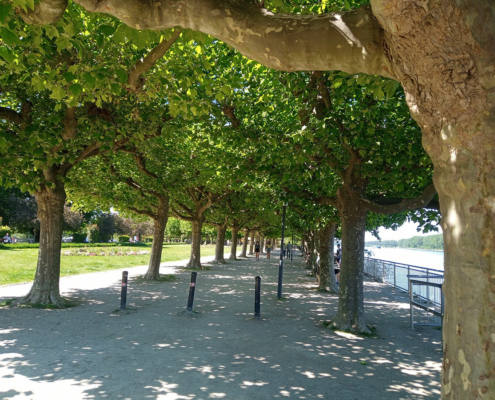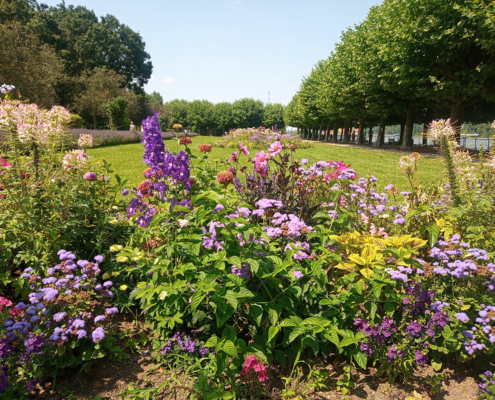Worms Rhine promenade
There are certainly towns on the Rhine that have a much longer promenade, but the promenade on the banks of the Rhine, bordered by harbour facilities, invites you to take a leisurely stroll and relax. Varied gastronomy (the home-brewed beer of the Hagenbräu restaurant is definitely worth a sip), the romantically picturesque planting, the view of the mighty Rhine or the sublime Hagen monument exude a Mediterranean serenity, especially on warm sunny days.
Why the Karl Kübel Bridge is popularly called the Terence Hill Bridge
Just five minutes’ walk from the Nibelungen Apartments, you initially encounter an inconspicuous pedestrian and cyclist bridge, which, however, became the focus of media attention a few years ago. It all started a few years ago when the city authorities christened the utilitarian concrete structure the Karl Kübel Bridge. Peter Englert, an actor and singer from Worms, didn’t think that was right and reminded the mayor at the time that he had promised to invite him to the bridge’s inauguration. Known for his whimsical ideas, Englert unceremoniously undertook the bridge inauguration himself and christened this important link between the city and the Rhine the Terence Hill Bridge.
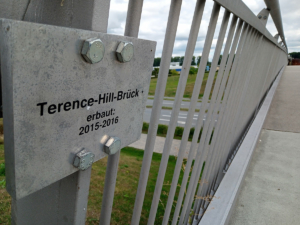 Now, of course, one can rightly ask what on earth the Italian actor has to do with a bridge in Worms? The answer is simple and leads back to 1966, when the Nibelungenlied was filmed at great expense as a two-parter. Among the cast was a certain Maria Girotti, who played the king’s brother Giselher and later became world famous under the name Terence Hill. Because Girotti alias Hill played a character from a Worms legend, it was a perfectly plausible reference to the Nibelungen city for Englert. At first, the Lord Mayor found the action only mildly amusing. But since it was an election year and the Lord Mayor wanted to be elected for another eight years as head of the city, he sensed a media-effective chance to score points with younger voters as well. The mayor in campaign mode contacted the retired actor and invited him to the city. He, in turn, did not miss the opportunity to visit “his bridge”. In the meantime, the news of this curious story spread all over Germany. The original name of the bridge, named after an industrialist who was socially engaged in Worms, was retained, but this did not change Terence Hill’s flying visit to the bridge, which was accompanied by a considerable media hype and lots of fans. There was also an entry in the city’s golden book. Today, a sign on the bridge commemorates those memorable days. The mayor, however, was not helped by the media attention. Only a few months later, in November, he was voted out of office.
Now, of course, one can rightly ask what on earth the Italian actor has to do with a bridge in Worms? The answer is simple and leads back to 1966, when the Nibelungenlied was filmed at great expense as a two-parter. Among the cast was a certain Maria Girotti, who played the king’s brother Giselher and later became world famous under the name Terence Hill. Because Girotti alias Hill played a character from a Worms legend, it was a perfectly plausible reference to the Nibelungen city for Englert. At first, the Lord Mayor found the action only mildly amusing. But since it was an election year and the Lord Mayor wanted to be elected for another eight years as head of the city, he sensed a media-effective chance to score points with younger voters as well. The mayor in campaign mode contacted the retired actor and invited him to the city. He, in turn, did not miss the opportunity to visit “his bridge”. In the meantime, the news of this curious story spread all over Germany. The original name of the bridge, named after an industrialist who was socially engaged in Worms, was retained, but this did not change Terence Hill’s flying visit to the bridge, which was accompanied by a considerable media hype and lots of fans. There was also an entry in the city’s golden book. Today, a sign on the bridge commemorates those memorable days. The mayor, however, was not helped by the media attention. Only a few months later, in November, he was voted out of office.
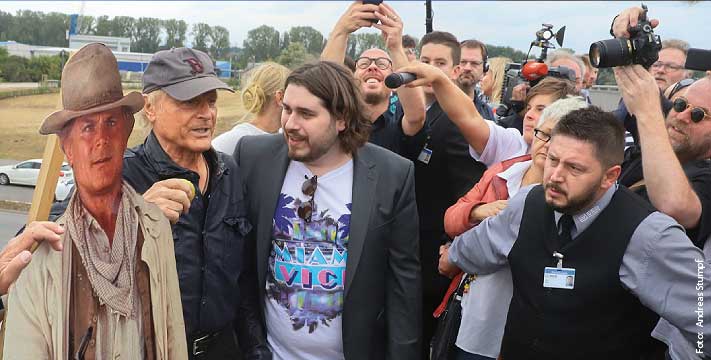
Kriemhild’s Rose Garden
Standing on the aforementioned Terence Hill / Karl Kübel Bridge, the view is deceptive, for the pulsating life on the Rhine is initially hidden behind mighty lime trees and two unsightly tanks that have been causing discontent among the population for decades. Once you have crossed the fairground, also known as Kissselswiese, and passed the boules playgrounds of a Worms club, you finally encounter the leisurely flowing Rhine. You are first greeted by a rose labyrinth at the foot of the Hag monument. Eichfelder, an artist from Worms, has been working on the Nibelungen for many decades. One of his long-cherished wishes was to give the city a Nibelungen that could be touched. The Rose Garden was not chosen arbitrarily. However, Eichfelder does not refer to the famous “Song of the Nibelungs”, but to the “Rose Garden Song”, which is less well-known today, was written in the 13th century and was extremely popular in the Middle Ages. Kriemhild is at the centre of the verse epic. At Worms on the Rhine, Kriemhild laid out a rose garden surrounded by a golden border. 224 shrub roses of ten different varieties now line the labyrinthine path through the rose garden, flanked by three lime trees, which are currently still in their infancy. From spring onwards, when the buds unfold into blossoms, the spiralling labyrinth enchants with its colours and fragrances. The labyrinth was opened in 2021.
Hagendenkmal
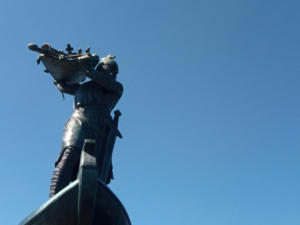 The monument with Hagen of Tronje stands proud and sublime on the banks of the Rhine. His gaze is determined to sink the precious Nibelungenhord into the waters of the Rhine in order to snatch it from Siegfried’s widow, Kriemhild. When Worms began to rediscover the myth of the Nibelungs in the early 1920s, it was decided to erect a monument to the myth. Why they chose to erect a monument to the villain of the play, of all people, remains the secret of the city authorities of the time. Perhaps it is because of the iconic character of the scene, which inextricably links the Nibelungen Horde with the myth-enshrouded Father Rhine? The galvano figure was created in 1905 by the art carver Johannes Hirt. Ironically, the monument once stood in the immediate vicinity of Kriemhild’s rose garden. In the course of the Nibelungen craze, a rose garden had already been laid out in the Worms city park (see Wäldchen) at the beginning of the twentieth century. Shortly afterwards, the monument was inaugurated as a direct neighbour. It stood there until 1932, after which the figure was moved to its present location.
The monument with Hagen of Tronje stands proud and sublime on the banks of the Rhine. His gaze is determined to sink the precious Nibelungenhord into the waters of the Rhine in order to snatch it from Siegfried’s widow, Kriemhild. When Worms began to rediscover the myth of the Nibelungs in the early 1920s, it was decided to erect a monument to the myth. Why they chose to erect a monument to the villain of the play, of all people, remains the secret of the city authorities of the time. Perhaps it is because of the iconic character of the scene, which inextricably links the Nibelungen Horde with the myth-enshrouded Father Rhine? The galvano figure was created in 1905 by the art carver Johannes Hirt. Ironically, the monument once stood in the immediate vicinity of Kriemhild’s rose garden. In the course of the Nibelungen craze, a rose garden had already been laid out in the Worms city park (see Wäldchen) at the beginning of the twentieth century. Shortly afterwards, the monument was inaugurated as a direct neighbour. It stood there until 1932, after which the figure was moved to its present location.
A Nibelungenturm as a gateway to the city
Even though nothing historical has survived in Worms from the time of the Nibelungs, i.e. the Middle Ages, the name can be found everywhere. So it is not surprising that the Rhine bridge that connects Worms with Hesse is called the Nibelungen Bridge. But the special 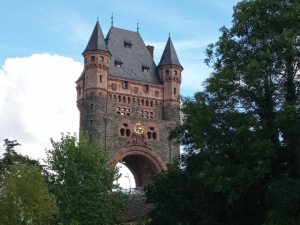 thing about it is not so much the name. Rather, it is the bridge tower, which is unique in this form on the Rhine. The bridge tower is 53 metres high and is also an impressive city portal. The mighty structure was inaugurated after three years of construction. Originally, the tower had a counterpart on the Hessian side. During the Second World War, it served for a time as a base for anti-aircraft guns. In March 1945, the tower to the east was finally blown up. The bridge, which was rebuilt in 1953, was also destroyed. Fortunately, the tower on the Worms side was spared. Above the roadway, the tower has eight floors, five of which are in use. Since 1976, it has served as a hostel for the scouts of the Association of Christian Scouts. It is usually open to the public once a year on the Open Monument Day on the second weekend in September. Those who take the trouble to climb the stairs are rewarded at the end with a sublime view over the city and into the vastness of Rheinhessen. zugleich auch eindrucksvolles Stadtportal ist. www.nibelungenturm.de
thing about it is not so much the name. Rather, it is the bridge tower, which is unique in this form on the Rhine. The bridge tower is 53 metres high and is also an impressive city portal. The mighty structure was inaugurated after three years of construction. Originally, the tower had a counterpart on the Hessian side. During the Second World War, it served for a time as a base for anti-aircraft guns. In March 1945, the tower to the east was finally blown up. The bridge, which was rebuilt in 1953, was also destroyed. Fortunately, the tower on the Worms side was spared. Above the roadway, the tower has eight floors, five of which are in use. Since 1976, it has served as a hostel for the scouts of the Association of Christian Scouts. It is usually open to the public once a year on the Open Monument Day on the second weekend in September. Those who take the trouble to climb the stairs are rewarded at the end with a sublime view over the city and into the vastness of Rheinhessen. zugleich auch eindrucksvolles Stadtportal ist. www.nibelungenturm.de

